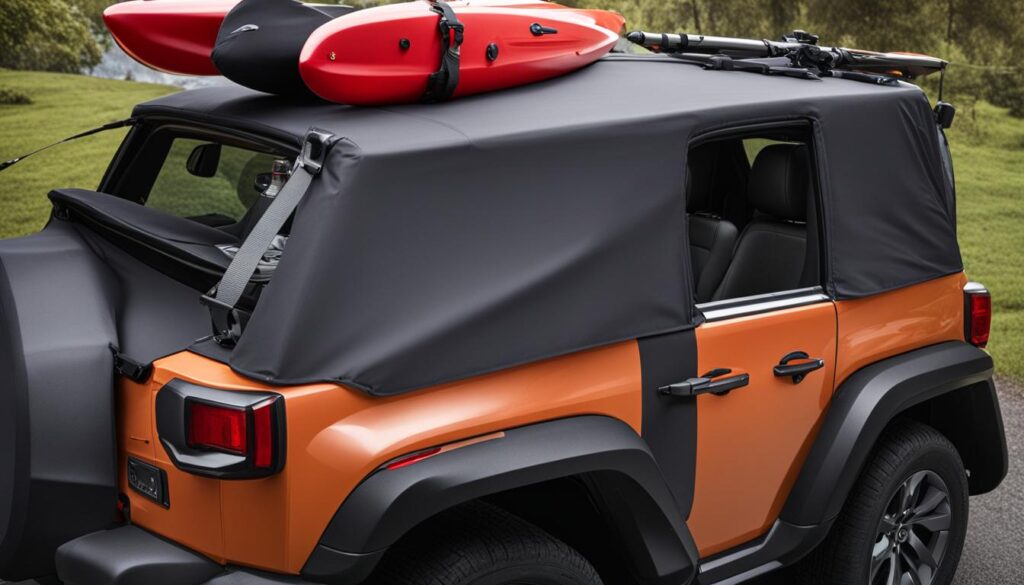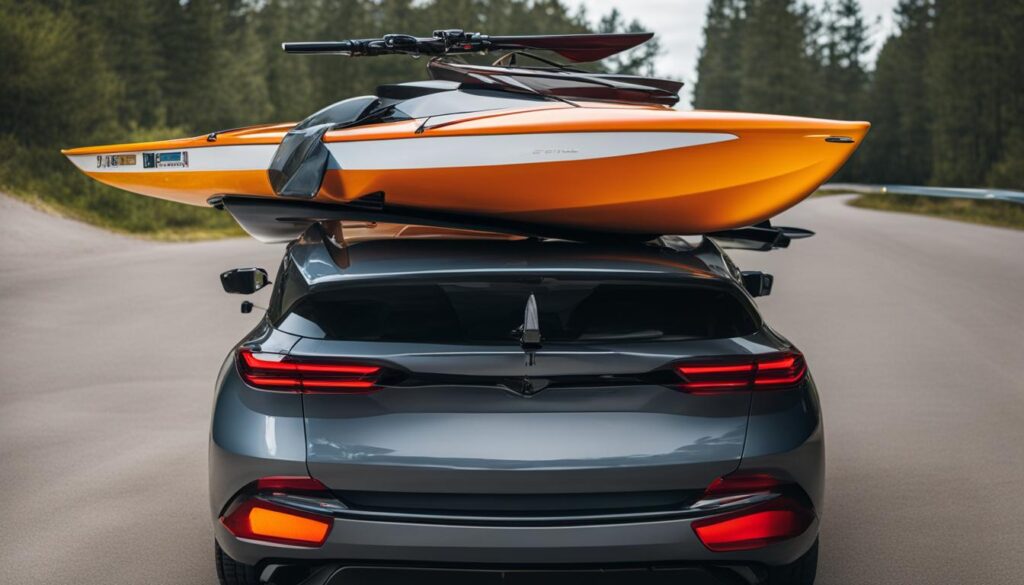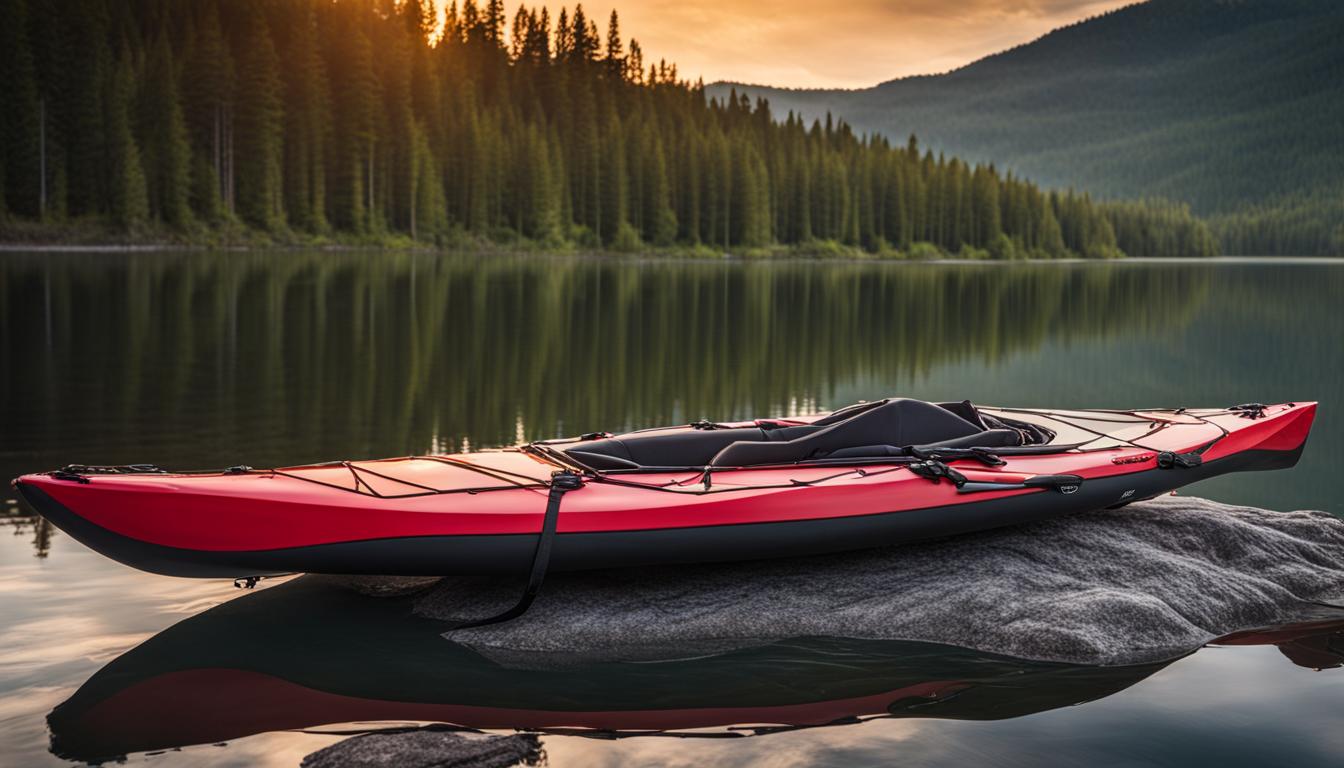When you’re ready for your next kayaking adventure, it’s important to take precautions to protect your vehicle’s paint from any potential damage. The last thing you want is scratches and scrapes ruining the pristine look of your car. In this article, we’ll provide you with tips and techniques to ensure that your car’s exterior remains in great condition while hauling your kayak.
Key Takeaways:
- Choose the right protective materials, such as microfiber applicators or clear films, to minimize the risk of rubbing and potential damage to your vehicle’s paint.
- Ensure proper installation and secure your kayak using reliable racks, like J Bars or cradle racks, to safeguard your car’s exterior.
- Use bow and stern lines to prevent the kayak from sliding and causing scratches or damage to your vehicle’s surface.
- Avoid common mistakes like over-tightening straps, allowing glass to rub together, and neglecting to double-check tie-downs during your journey.
- In case of accidents, professionals can repair and restore your damaged kayak to its original state.
Understanding the Risks of Kayak Tie Downs
When it comes to transporting kayaks, it’s important to be aware of the potential risks that tie downs can pose to your vehicle’s paintwork. While tie downs are essential for securing your kayak during transportation, the rubbing and tension from the straps can inadvertently cause damage to your car’s exterior, particularly the front hood and bumper.
To protect your vehicle’s paint from potential scratches, dents, or abrasions, it is essential to take preventive measures and use protective materials or accessories. These can create a barrier between the straps and your car’s paint, minimizing the risk of rubbing and potential damage. By being proactive and investing in the right protection methods, you can ensure that your vehicle remains in great condition even when transporting your kayak.
Protective Materials and Accessories
There are several options available when it comes to protecting your vehicle’s paint from the straps used to secure your kayak. One popular choice is to use microfiber applicators or foam wrapped in microfiber towels. These materials provide a soft and cushioned surface between the straps and your car’s paint, reducing the potential for friction and damage.
Another option is to use clear films similar to screen protectors. These films are specifically designed to adhere to your car’s paint and act as a protective layer. They are durable, transparent, and can be easily removed without leaving any residue. This ensures that your vehicle’s paint remains untouched while still allowing you to securely tie down your kayak.
Proper Installation and Maintenance
In addition to using protective materials, it is crucial to ensure that your tie downs are installed correctly and properly maintained. Make sure the straps are securely tightened, but avoid over-tightening, as excessive tension can cause unnecessary pressure on your car’s paintwork.
Regularly check the straps during your journey to ensure they remain tight and secure. If you notice any loose ends or flapping lines, be sure to secure them properly to prevent them from potentially damaging your vehicle’s surface. Remember, a little extra care and attention can go a long way in protecting your car’s paint from the risks associated with kayak tie downs.
| Common Risks of Kayak Tie Downs | Preventive Measures |
|---|---|
| Rubbing and tension can cause paint scratches and abrasions | Use microfiber applicators, foam wrapped in microfiber towels, or clear films to create a protective barrier |
| Over-tightening the straps can lead to excessive pressure on the car’s paint | Ensure proper installation and avoid over-tightening the straps |
| Loose ends and flapping lines can cause damage to the vehicle’s surface | Regularly check and secure any loose ends or flapping lines |
Choosing the Right Protection Materials
When it comes to transporting kayaks and protecting your vehicle’s paint, choosing the right materials is crucial. There are several options available to ensure that your car’s exterior remains in great condition during kayak transport.
One popular choice is using microfiber applicators. These soft and gentle materials can be placed between the kayak straps and your car’s paint, creating a protective barrier. The microfiber fabric helps to minimize rubbing and prevent any potential damage.
Another option is foam wrapped in microfiber towels. By wrapping the foam around the straps, you can add an extra layer of protection to avoid any contact with your vehicle’s paint. The microfiber towels further reduce friction, providing a buffer between the straps and your car.
Clear films, similar to screen protectors, are also a great choice for protecting your vehicle’s paint during kayak transport. These films are applied directly to the areas that come into contact with the straps, creating a durable shield against rubbing and potential damage. They are transparent, so they won’t affect the appearance of your car.

By choosing the right protection materials, you can prevent any unwanted scratches or marks on your vehicle’s paint. Whether you opt for microfiber applicators, foam wrapped in towels, or clear films, these options provide an effective barrier between your kayak straps and your car’s exterior, giving you peace of mind during transportation.
Safeguarding Your Car’s Exterior with Kayaks: Tips for Protecting Car Paint from Kayak Racks
When it comes to transporting kayaks, using kayak racks can provide a secure and efficient solution. Not only do they make loading and unloading your kayak easier, but they also help protect your vehicle’s paint from potential damage. Here are some essential tips for using kayak racks to safeguard your car’s exterior.
Proper Installation
Before you start using kayak racks, it’s crucial to ensure proper installation. Follow the manufacturer’s instructions carefully, making sure that the racks are securely fastened to your vehicle. A loose or incorrectly installed rack can increase the risk of scratches or dents to your car’s paint.
Centering and Strapping
When placing your kayak on the racks, make sure it is centered to distribute the weight evenly. This helps prevent any imbalance that could potentially damage your vehicle’s paint. Once your kayak is properly positioned, use cam buckle or ratchet straps to secure it tightly to the racks. This ensures that it stays in place during transportation, minimizing any movement that could cause scratches or other damage.
Securing Loose Ends
After securing your kayak, it’s important to take care of any loose ends of the straps. Unsecured straps can flap in the wind, potentially scratching or hitting your vehicle’s paint. To prevent this, neatly tie or secure any excess straps to avoid any accidental contact with your car’s exterior.
By following these tips, you can confidently transport your kayak using racks while keeping your vehicle’s paint protected. Remember to double-check your installation, center and strap your kayak securely, and secure any loose ends of the straps. With these precautions in place, you can enjoy your kayaking adventures without worrying about damaging your car’s paint.
The Importance of Bow and Stern Lines
When it comes to transporting your kayak, it’s not just about securing it to the roof rack. The use of bow and stern lines plays a crucial role in ensuring the safety of your vehicle’s surface and preventing scratches caused by kayak carriers.
Bow and stern lines are additional straps that connect the front and back of your kayak to the bumpers or other secure points on your vehicle. These lines help to prevent the kayak from sliding forward or backward during transportation, especially during sudden stops or turns.
By using bow and stern lines, you can provide extra stability to your kayak and eliminate the risk of it potentially damaging your vehicle’s paint. These lines should be properly secured, and their tension should be adjusted to keep the kayak firmly in place without putting excessive pressure on the car’s surface.
Remember, the key is to keep your vehicle’s paint protected while enjoying your kayaking adventures. By incorporating bow and stern lines into your kayak transport routine, you can minimize the risk of scratches or other damage caused by the movement of the kayak and ensure a stress-free journey.

Table: Comparison of Bow and Stern Line Materials
| Material | Pros | Cons |
|---|---|---|
| Nylon Rope | – Affordable and widely available – Strong and durable |
– Can cause friction and potential scratches if not properly protected |
| Strap with Buckle | – Easy to adjust and secure – Soft material, minimizing the risk of scratches |
– May require additional padding to prevent friction |
| Bungee Cord with Hooks | – Provides flexibility and elasticity – Quick and easy to secure |
– May not provide enough stability for larger kayaks – Hooks can potentially scratch the vehicle |
“Using bow and stern lines is like adding an extra layer of protection for your vehicle’s paint. It’s a small investment of time and effort that can go a long way in preserving the beauty of your car while enjoying your kayaking adventures.” – Kayak Enthusiast
Common Mistakes to Avoid
When it comes to transporting kayaks on the roof of your vehicle, there are some common mistakes that can lead to damage to your car’s paintwork. By being aware of these mistakes and taking preventive measures, you can ensure the safety of your vehicle’s exterior.
One mistake to avoid is over-tightening the straps. While it’s important to secure your kayak properly, applying excessive force when tightening the straps can cause unnecessary pressure on your car’s paint, leading to scratches or even paint chips. Remember to tighten the straps just enough to secure the kayak without putting excessive pressure on your vehicle.
Another mistake is allowing glass and glass to rub together. If you have multiple kayaks loaded on your roof rack, make sure to use padding or foam between them to prevent any rubbing or scratching. This will help protect the paint on your car and keep it looking pristine.
Table: Common Mistakes to Avoid when Transporting Kayaks
| Mistake | Effect |
|---|---|
| Over-tightening straps | Scratches or paint chips on the vehicle’s paint |
| Glass and glass rubbing | Paint damage from friction between kayaks |
| Not securing flapping lines | Potential paint damage from loose straps |
| Neglecting to double-check tie-downs | Unsecured kayaks and potential damage to your vehicle |
It’s also important to secure any loose ends of the straps. Flapping straps can cause damage to your car’s paint, especially at high speeds. Take the time to secure any loose ends and keep them tucked away to minimize the risk of paint damage.
Lastly, don’t forget to double-check your tie-downs after a few minutes of driving. Vibrations and movement can cause the straps to become loose, which can endanger the safety of your kayak and potentially damage your vehicle’s paint. Taking a moment to check and tighten the straps during your journey can help prevent any accidents or paint damage.
Handling Vehicle Accidents
While we hope that you never have to deal with a car accident while transporting your kayak, accidents can happen. In the unfortunate event of a collision or any other car accident involving your kayak, it’s important to know that there are professionals who specialize in repairing transportation-damaged kayaks. They have the expertise to assess the damage and restore your kayak to its original state, ensuring that you can continue enjoying your outdoor adventures without worry.
Regardless of whether your kayak is made of fiberglass or plastic, these repair specialists can handle the necessary repairs. In the case of fiberglass kayaks, the repairs may add some additional weight, but rest assured that your kayak will be as good as new. With their knowledge and skills, these professionals can effectively address any car paint damage caused by kayak accidents and restore both the functionality and appearance of your kayak.
It is essential to rely on professionals to repair your transportation-damaged kayak after a car accident. Attempting to fix it yourself may result in further damage or improper repairs that could compromise the kayak’s integrity and performance.
When faced with a car accident involving your kayak, don’t panic. Contact a professional kayak repair service that specializes in handling transportation-related damages. They can guide you through the necessary steps, assess the extent of the damage, and provide the best course of action to restore your kayak. With their expertise, you can have peace of mind knowing that your kayak will be in capable hands and that you can get back to your kayaking adventures in no time.
| Benefits of Professional Kayak Repair After Accidents |
|---|
| 1. Expert assessment of damage and necessary repairs |
| 2. Restoration of kayak’s functionality and appearance |
| 3. Specialization in transportation-related damages |
| 4. Ensures proper repairs to maintain kayak integrity |
| 5. Saves time and effort from attempting DIY repairs |
Conclusion
Protecting your vehicle’s paint when transporting kayaks is essential to maintaining its appearance and value. By implementing the right methods and precautions, you can ensure that your car’s exterior remains in great condition throughout your journeys.
First and foremost, choosing the right protection materials is crucial. Consider using microfiber applicators, foam wrapped in microfiber towels, or clear films similar to screen protectors. These materials act as a barrier between the straps and your car’s paint, minimizing the risk of rubbing and potential damage.
Furthermore, properly securing the kayak is vital. Whether you opt for kayak racks or tie-down straps, make sure to install and use them correctly. Ensure that the kayak is centered and securely fastened, and don’t forget to secure any loose ends of the straps to prevent flapping and potential damage.
Additionally, the importance of bow and stern lines should not be overlooked. These lines provide an extra level of safety by preventing the kayak from sliding forward or backward during transportation. By properly securing the bow and stern lines, you can avoid scratches or damage caused by the kayak carriers.
Remember to periodically check the tie-downs during your journey and make any necessary adjustments. By being aware of common mistakes, such as over-tightening the straps or allowing glass and glass to rub together, you can ensure the safety of your car’s exterior.
In the unfortunate event of a car accident involving your kayak, there are professionals who specialize in repairing transportation-damaged kayaks. They can restore your kayak to its original state, keeping you ready for your next outdoor adventure.
With these methods for protecting your car’s paint from kayaks, you can enjoy your kayaking adventures without worrying about damaging your vehicle. Take the necessary precautions, use the right materials, and enjoy the open water with peace of mind.
FAQ
What are the risks of using kayak tie downs without protection?
The rubbing from the straps used to secure the kayak can cause damage to the front hood and bumper of your vehicle.
How can I protect my vehicle’s paint from kayak tie downs?
You can use materials like microfiber applicators, foam wrapped in microfiber towels, or clear films to create a barrier between the straps and your car’s paint.
What are some options for safely transporting kayaks on my vehicle?
Kayak racks like J Bars or cradle racks can provide a secure and efficient way to transport your kayak while protecting your vehicle’s paint.
Why do I need to use bow and stern lines when transporting a kayak?
Bow and stern lines prevent the kayak from sliding forward or backward during transportation, reducing the risk of scratches or damage to the vehicle’s paint.
What are some common mistakes to avoid when transporting kayaks?
Some common mistakes include over-tightening the straps, allowing glass and glass to rub together, not securing flapping lines, and neglecting to double-check tie-downs after a few minutes of driving.
Are there services available to repair kayaks damaged during transportation accidents?
Yes, there are companies that specialize in repairing transportation-damaged kayaks, even if they are in pieces. Professionals can handle repairs for both fiberglass and plastic kayaks, making them as good as new.





